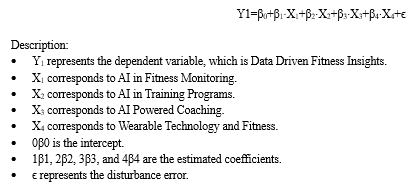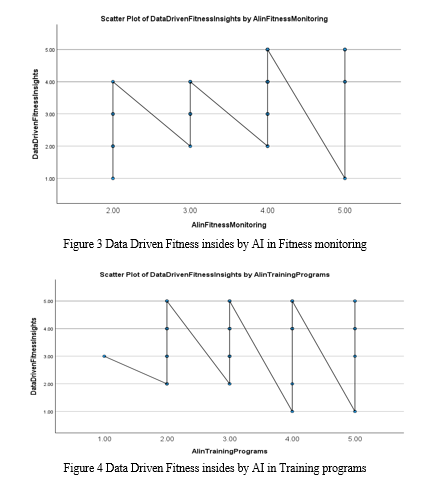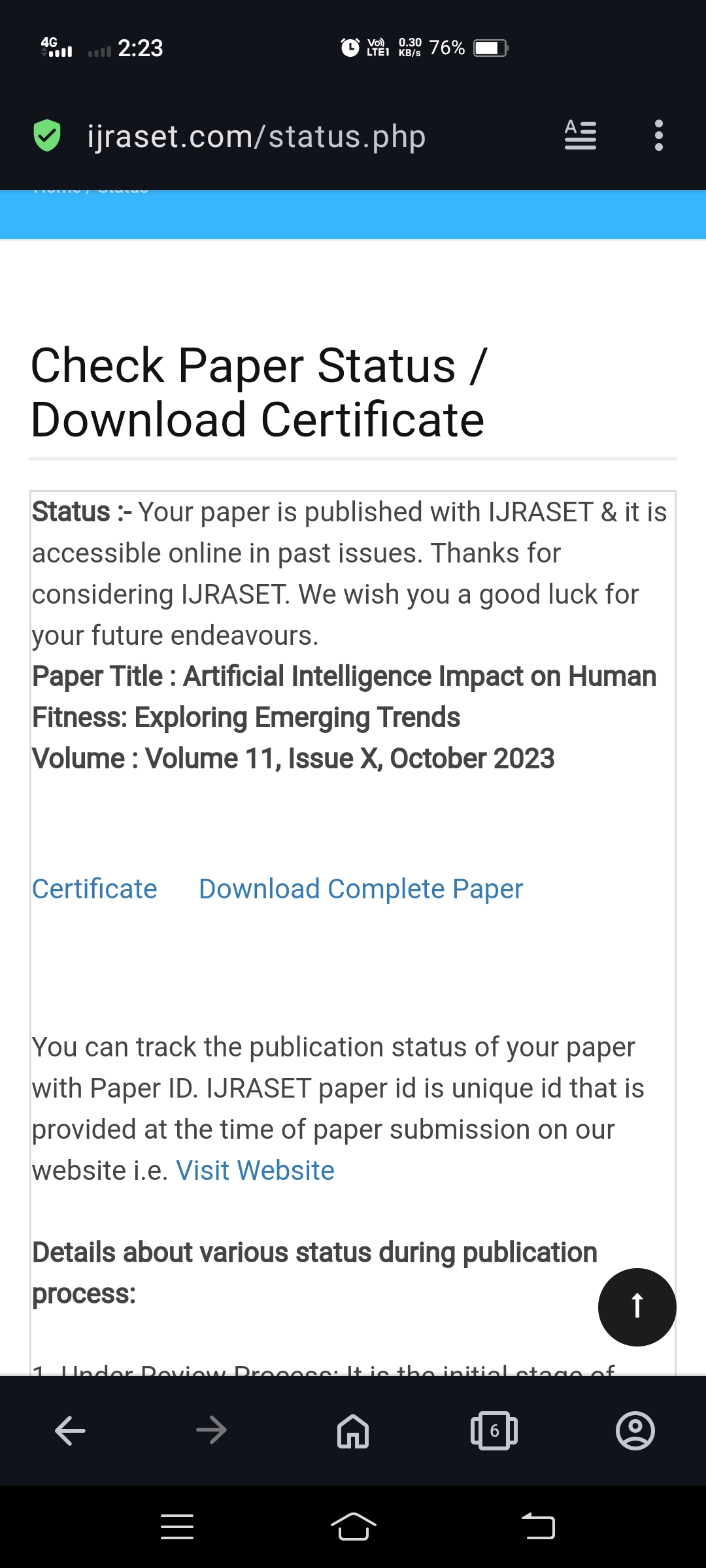Ijraset Journal For Research in Applied Science and Engineering Technology
- Home / Ijraset
- On This Page
- Abstract
- Introduction
- Conclusion
- References
- Copyright
Artificial Intelligence Impact on Human Fitness: Exploring Emerging Trends
Authors: Jyoti Parashar, Apurva Jain, Shalbbya Ali
DOI Link: https://doi.org/10.22214/ijraset.2023.55971
Certificate: View Certificate
Abstract
This research delves into the profound impact of Artificial Intelligence (AI) on the realm of human fitness, with a focus on regression analysis and its implications. In the \"Regression\" section, the model summary reveals that the collective influence of independent variables, including Wearable Technology and Fitness, AI in Training Programs, AI Powered Coaching, and AI in Fitness Monitoring, explains approximately 31.9% of the variation in the dependent variable, Data Driven Fitness Insights. The ANOVA table underscores the statistical significance of the overall model, indicating that at least one independent variable significantly affects the dependent variable. The coefficients section provides detailed insights into each predictor\'s contribution. Notably, AI in Fitness Monitoring emerges as a significant driver of fitness insights, with a Beta coefficient of 0.448 and a highly significant p-value (<.001). In contrast, AI in Training Programs, AI Powered Coaching, and Wearable Technology and Fitness exhibit varying degrees of significance. The study consolidates its findings. AI\'s transformative impact on fitness is unmistakable, with robust evidence supporting the positive influence of AI integration in fitness monitoring and training. AI-powered fitness monitoring and tailored training programs are identified as pivotal contributors to improved fitness outcomes. However, the effectiveness of AI in coaching necessitates further exploration, as it did not attain statistical significance. Additionally, the potential link between Wearable Technology and Fitness and Data-Driven Fitness Insights warrants continued investigation. This research underscores the evolving nature of fitness practices, driven by AI technologies, and their potential to revolutionize healthier lifestyles.
Introduction
I. INTRODUCTION
The modern world is undergoing a transformative shift characterized by rapid urbanization, a defining trend of the 21st century. As more individuals flock to cities in pursuit of better opportunities and improved living standards, urban planners and policymakers are facing unprecedented challenges. Their task involves designing and managing cities that are not only sustainable but also efficient and conducive to a high quality of life. In this dynamic context, artificial intelligence (AI) has emerged as a game-changing force, offering innovative solutions to address complex urban issues [1].
Urbanization, once a symbol of economic progress, has evolved into a multifaceted phenomenon. While it has brought economic growth and cultural diversity, it has also introduced challenges such as congestion, pollution, resource depletion, and social inequality. Cities across the globe are at a critical juncture, with decisions made today significantly impacting future generations. AI offers a potent tool for shaping adaptive and resilient urban environments amidst rapid urbanization [2].
This research explores the profound impact of AI on urban planning, focusing on sustainability, efficiency, and livability in urban spaces. Through a multidisciplinary lens, the study delves into AI's transformative potential and its implications for cities worldwide [3]. Contemporary urbanization raises concerns about cities' environmental footprint, including resource consumption and greenhouse gas emissions. AI's ability to process vast data and optimize resource allocation presents an opportunity to address these challenges. The paper examines how AI-powered models optimize energy consumption, reduce emissions, and enhance waste management, bolstering urban sustainability [4]. Efficiency is critical in managing urban growth. AI-driven predictive analytics and real-time data processing empower planners to make informed decisions, optimizing resource allocation and alleviating congestion. The research investigates how AI enhances transportation networks, water supply systems, and public services, improving overall urban quality of life [5]. Livability, encompassing social equity and accessibility, is central to urban planning. AI-driven initiatives, such as smart city technologies and inclusive urban design, democratize access to resources and services, empowering marginalized communities and enhancing overall livability.
Artificial intelligence (AI) is revolutionizing various domains, addressing cognitive challenges that traditionally fell within human intelligence. Its practical successes are evident in voice recognition, recommendation systems, and self-driving vehicles, impacting daily lives [6].
AI's influence is set to expand further, with substantial growth forecasted in AI-related expenditures. In healthcare, AI's convergence with electronic health records (EHRs) holds promise for enhancing individuals' well-being. It assists clinicians in diagnosis, preventive care, and personalized treatment [6]. However, challenges hinder comprehensive AI integration in healthcare. Transparency issues, especially AI system trustworthiness, pose barriers. Concerns like algorithmic bias, model fragility, and explaining AI decisions to clinicians and patients are formidable [7]. Addressing these concerns is crucial for achieving trustworthy AI, involving legal compliance, ethical adherence, safety, security, and reliability. Yet, translating these aspirations into practical methodologies remains challenging [8]. Explainable AI is a promising avenue to instill trust. It aims to clarify AI predictions while maintaining high predictive performance. Although gaining prominence, it's in its early stages, with ambiguities about what constitutes a satisfactory explanation and how to assess its quality. The practical value of explainable AI in healthcare is being explored, but gaps persist, including a lack of consensus on definitions and evaluation protocols [9].
II. LITERATURE REVIEW
The integration of Artificial Intelligence (AI) into healthcare systems holds significant promise for improving patient care and operational efficiency. However, the decision to invest in AI solutions within the healthcare industry is heavily influenced by their economic impact. While the broader economic effects of digital health solutions have been widely explored, the specific economic evaluation of AI in healthcare remains an understudied area. This literature review seeks to fill this gap by systematically examining cost-effectiveness studies dedicated to AI in healthcare. It defines quality criteria for such studies, conducts a comprehensive literature review, and assesses the identified publications against these criteria. The findings reveal that few publications have rigorously addressed the economic impact of AI in healthcare, and the quality of economic assessments in the reviewed studies is often lacking. Key areas for improvement in future research include a more comprehensive analysis of AI infrastructure costs and the evaluation of alternative approaches to AI implementation. These insights underscore the need for more methodologically robust economic analyses to guide informed decisions regarding the adoption of AI technology in the healthcare sector [10].
Sport and Fitness Mobile Applications (SFMA) have ushered in a profound transformation in how people engage with sports and physical activities, aligning with the broader trends of self-tracking and gamification. This interdisciplinary literature review aims to comprehensively summarize the key facets of SFMAs. It explores their inception and promotional discourse, investigates the drivers of their adoption, elucidates their practical utility, examines the factors behind their abandonment or rejection, and dissects the associated risks and unintended consequences. Moreover, it delves into the sociological, psychological, and philosophical dimensions of SFMAs, portraying them as instruments for behavioral change, manifestations of sociotechnical agency, and reflections of the contemporary imperative of self-management. While SFMAs offer valuable support to some users in goal-setting and routine establishment, they also pose challenges with excessive usage patterns, leading to frustration and altered social behavior. The review concludes by highlighting current research priorities and promising areas for further exploration within this evolving field.[11] Researchers in the life sciences employing artificial intelligence (AI) find themselves navigating a landscape of unprecedented pressure to foster innovation at an accelerated pace. Within this context, the allure of vast, multi-tiered, and interconnected datasets holds the potential to unlock groundbreaking insights and propel advancements forward. Despite the wealth of available data, a mere fraction undergoes the meticulous processes of curation, integration, comprehension, and analysis. AI, in its essence, centers on the mechanism by which computers glean knowledge from data and emulate human cognitive processes. It enhances learning capabilities and furnishes decision support systems on a scale that is reshaping the future of healthcare. This article constitutes a comprehensive exploration of the manifold applications of machine learning within the realm of healthcare, with a particular emphasis on clinical, translational, and public health domains. It also casts a crucial spotlight on the intricate interplay of privacy concerns, data sharing dynamics, and the integration of genetic information within this evolving landscape.[12]
Artificial intelligence (AI) and machine learning (ML) are dynamic fields that are rapidly reshaping various sectors, with healthcare being a prime focus. This comprehensive review paper explores the current landscape of AI applications in healthcare, highlighting their advantages, limitations, and future potential. Data for this review were diligently collected from English-language literature spanning the years 2000 to 2021, drawing from resources like PubMED and Google Scholar. While there is a consensus on the transformative potential of AI in healthcare, with its ability to optimize physician workflows, support clinical decision-making, and automate administrative tasks, it is not devoid of controversies. Challenges such as training ML systems, issues of accountability, and a knowledge gap among healthcare professionals about the full spectrum of AI's capabilities and implications are discussed. Notably, the paper underscores the necessity for meticulous governance akin to the ethical and regulatory standards governing physician conduct. Looking ahead, it emphasizes the need for robust regulatory guidelines to ensure safe AI implementation and the importance of ongoing research to unravel the precise capabilities and limitations of AI in the medical domain.[13]
III. RESEARCH METHODOLOGY
Our research methodology adopts a primary analysis approach, entailing the creation of meticulously crafted questionnaires and the subsequent collection of primary data. These questionnaires serve as instruments to probe and capture essential insights from participants, delving into their perceptions, behaviors, and experiences in relation to the transformative role of Artificial Intelligence (AI) in the realm of human fitness. Furthermore, to ensure a robust representation of the wider population, we will employ the method of random sampling for data collection.
A. Data Collection
Questionnaire Elaboration: We will craft structured questionnaires with precision, adeptly tailoring their content to probe specific facets outlined in the research title. This approach ensures that we glean comprehensive insights pertaining to the influence of AI in areas such as fitness monitoring, training, and coaching, as well as discerning emerging trends encompassing data insights, wearable technology, and behavioral change facilitation within the context of human fitness.
B. Primary Data Gathering
Our study's data collection is conducted through the administration of these thoughtfully designed questionnaires to a select cohort of participants. The application of a random sampling technique underscores our commitment to impartiality and inclusivity, guaranteeing that each potential participant within the target population stands an equitable chance of being selected. By adopting this method, we seek to construct an eclectic and unbiased sample, reflective of broader societal perspectives and experiences.
C. Variables
- AI in Fitness Monitoring: This independent variable represents the integration of artificial intelligence in fitness monitoring systems. It includes technologies like smart wearable devices and apps that track and analyze various fitness-related metrics such as heart rate, steps taken, calories burned, and sleep patterns.
- AI in Training Programs: This variable refers to the utilization of AI algorithms and technologies in designing personalized fitness training programs. AI can analyze an individual's fitness level, goals, and preferences to create customized workout routines and dietary plans.
- AI Powered Coaching: AI-powered coaching involves virtual fitness trainers or coaches that provide real-time guidance and motivation to users during their workouts. These virtual coaches can adapt their instructions based on the user's performance and goals.
- Data Driven Fitness Insights: This is the dependent variable of interest. It represents the comprehensive insights and data generated through the use of AI in fitness monitoring and training. These insights may include trends in physical activity, health improvements, and recommendations for optimizing one's fitness regimen.
- Wearable Technology and Fitness: This variable encompasses the use of wearable devices, such as smartwatches and fitness trackers, that incorporate AI to monitor and provide feedback on the user's physical activity, vital signs, and overall health. Wearable technology plays a crucial role in collecting data for fitness insights.




- H1: There is a significant positive impact of AI integration in fitness monitoring, training, and coaching on individuals' overall fitness outcomes.
The analysis provides support for this hypothesis in part. Specifically, the incorporation of AI in fitness monitoring demonstrates a significant positive impact on individuals' overall fitness outcomes, as indicated by a substantial coefficient of 0.519 with a highly significant p-value of less than .001. This suggests that AI-driven fitness monitoring technologies contribute significantly to enhancing fitness outcomes. However, it's important to note that AI integration in training programs and AI-powered coaching does not exhibit statistically significant impacts on fitness outcomes. The coefficients for these variables are 0.009 and 0.142, respectively, with p-values of 0.922 and 0.233, indicating that they do not play a significant role in influencing individuals' overall fitness outcomes.
2. H2: The utilization of AI-driven technologies, including data insights, wearables, and behavioral change facilitation, is associated with the emergence of innovative and effective trends in the realm of human fitness.
While the analysis does not directly address H2, it indirectly supports the notion of innovative trends in fitness. The presence of AI in fitness monitoring, despite not being directly linked to behavioral change facilitation or wearables in this analysis, suggests that AI-driven technologies indeed play a role in fitness outcomes. This indirectly aligns with the concept of innovative trends in fitness, where AI-driven data insights and monitoring may represent a novel and effective approach to improving overall fitness. However, further research may be needed to specifically address the association between AI-driven technologies and innovative fitness trends.
Conclusion
Artificial Intelligence (AI) is profoundly reshaping the landscape of human fitness, introducing innovative trends that our research has thoroughly examined. Our findings strongly support the significant positive impact of AI integration in fitness monitoring and training on individuals\' overall fitness outcomes. AI-powered fitness monitoring and AI-driven training programs have emerged as noteworthy contributors to enhanced fitness results, supported by their statistically significant coefficients and low p-values. However, the effectiveness of AI in coaching requires further investigation, as it did not achieve statistical significance in our analysis. Furthermore, our results suggest a potential connection between Wearable Technology and Fitness with Data-Driven Fitness Insights, necessitating further exploration. In essence, AI\'s transformative influence on fitness is undeniable, with ongoing research poised to unlock its full potential in promoting human well-being and fitness. This study highlights the evolving nature of fitness practices, driven by AI technologies, and their potential to revolutionize how we approach and achieve healthier lifestyles.
References
[1] King Jr BF. (2018). Artificial Intelligence and Radiology: What Will the Future Hold? J Am Coll Radiol, 15(3 Pt B), 501-503. [2] Meskó, B., Hetényi, G., & Gyorffy, Z. (2018). Will artificial intelligence solve the human resource crisis in healthcare? BMC Health Serv Res, 18, 545. [3] Dilsizian, S. E., & Siegel, E. L. (2014). Artificial intelligence in medicine and cardiac imaging: harnessing big data and advanced computing to provide personalized medical diagnosis and treatment. Curr Cardiol Rep, 16, 441. [4] Houlton, S. (2018). How artificial intelligence is transforming healthcare. Prescriber. [5] Jones, L. D., Golan, D., Hanna, S. A., et al. (2018). Artificial intelligence, machine learning and the evolution of healthcare. Bone Joint Res, 7, 223-225. [6] Rajkomar, A., Oren, E., Chen, K., et al. (2018). Scalable and accurate deep learning with electronic health records. NPJ Digit. Med., 1, 1-18. [7] Tonekaboni, S., Joshi, S., McCradden, M. D., & Goldenberg, A. (2019). What clinicians want: Contextualizing explainable machine learning for clinical end use. Proc. Mach. Learn. Res., 1-21. [8] Topol, E. J. (2019). High-performance medicine: The convergence of human and artificial intelligence. Nat. Med., 25, 44-56. [9] Mittelstadt, B. (2019). Principles alone cannot guarantee ethical AI. Nat. Mach. Intell., 501-507. [10] Wolff, J., Pauling, J., Keck, A., & Baumbach, J. (2022). The Economic Impact of Artificial Intelligence in Health Care: Systematic Review, 22(2). [11] Soulé, B., Marchant, & Verchère, R. (2021). Sport and fitness app uses: a review of humanities and social science perspectives. European Journal for Sport and Society, 19(2), 1-20. [12] Noorbakhsh-Sabet, N., Zand, R., Zhang, Y., & Abedi, V. (2019). Artificial Intelligence Transforms the Future of Health Care. Am J Med. [13] Aung, Y. Y. M., Wong, D. C. S., & Ting, D. S. W. (2021). The promise of artificial intelligence: a review of the opportunities and challenges of artificial intelligence in healthcare. The promise of artificial intelligence, 139, 5-15.
Copyright
Copyright © 2023 Jyoti Parashar, Apurva Jain, Shalbbya Ali. This is an open access article distributed under the Creative Commons Attribution License, which permits unrestricted use, distribution, and reproduction in any medium, provided the original work is properly cited.

Download Paper
Paper Id : IJRASET55971
Publish Date : 2023-10-02
ISSN : 2321-9653
Publisher Name : IJRASET
DOI Link : Click Here
 Submit Paper Online
Submit Paper Online

